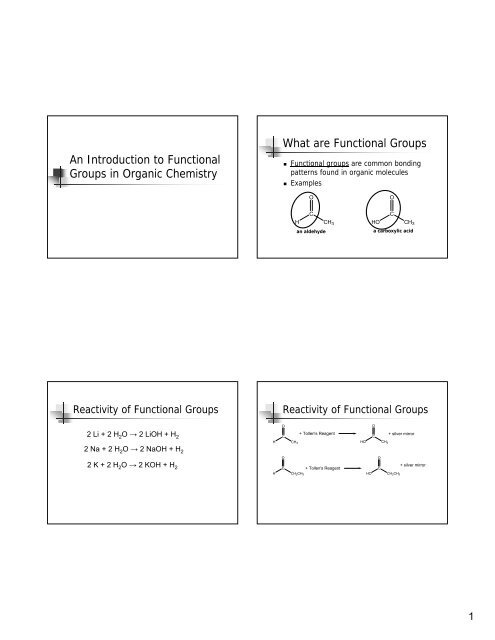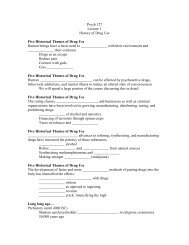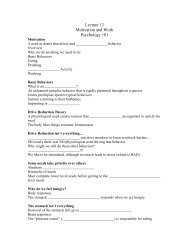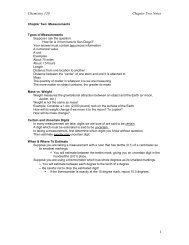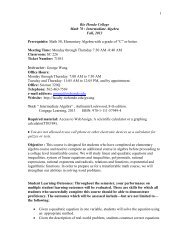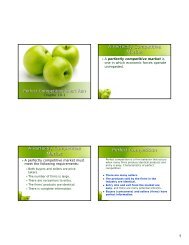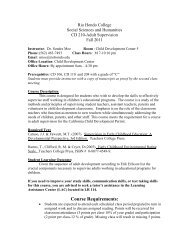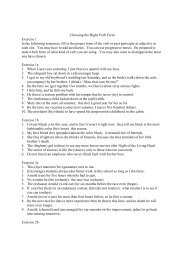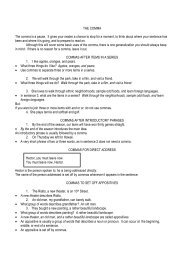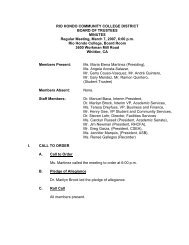An Introduction to Functional Groups in Organic Chemistry What are ...
An Introduction to Functional Groups in Organic Chemistry What are ...
An Introduction to Functional Groups in Organic Chemistry What are ...
You also want an ePaper? Increase the reach of your titles
YUMPU automatically turns print PDFs into web optimized ePapers that Google loves.
<strong>An</strong> <strong>Introduction</strong> <strong>to</strong> <strong>Functional</strong><br />
<strong>Groups</strong> <strong>in</strong> <strong>Organic</strong> <strong>Chemistry</strong><br />
<strong>What</strong> <strong>are</strong> <strong>Functional</strong> <strong>Groups</strong><br />
• <strong>Functional</strong> groups <strong>are</strong> common bond<strong>in</strong>g<br />
patterns found <strong>in</strong> organic molecules<br />
• Examples<br />
O<br />
C<br />
H CH 3<br />
an aldehyde<br />
O<br />
C<br />
HO CH 3<br />
a carboxylic acid<br />
Reactivity of <strong>Functional</strong> <strong>Groups</strong><br />
Reactivity of <strong>Functional</strong> <strong>Groups</strong><br />
O<br />
O<br />
2 Li + 2 H 2 O → 2 LiOH + H 2<br />
H<br />
C<br />
+ Tollen's Reagent + silver mirror<br />
C<br />
CH 3<br />
HO CH 3<br />
2 Na + 2 H 2 O → 2 NaOH + H 2<br />
O<br />
O<br />
2 K + 2 H 2 O → 2 KOH + H 2<br />
H<br />
C<br />
CH 2CH 3<br />
+ Tollen's Reagent<br />
HO<br />
C<br />
CH 2CH 3<br />
+ silver mirror<br />
1
Reactivity of <strong>Functional</strong> <strong>Groups</strong><br />
<strong>Functional</strong> <strong>Groups</strong> Conta<strong>in</strong><strong>in</strong>g<br />
Carbon and Hydrogen Only<br />
H<br />
HO<br />
O<br />
O<br />
C<br />
O<br />
C<br />
C<br />
H<br />
R<br />
+ Tollen's Reagent C<br />
R<br />
+ Tollen's Reagent<br />
CH 2<br />
C<br />
OH<br />
O<br />
HO<br />
O<br />
R<br />
no silver mirror<br />
produced<br />
+ Tollen's Reagent <br />
+ silver mirror<br />
• Alkanes conta<strong>in</strong> only sp 3 hybridized carbon<br />
a<strong>to</strong>ms, and therefore possess only s<strong>in</strong>gle<br />
bonds.<br />
• A compound is only called an alkane if it conta<strong>in</strong>s<br />
none of the other functional groups.<br />
• Alkenes conta<strong>in</strong> at least one carbon-carbon<br />
double bond.<br />
• Alkynes conta<strong>in</strong> at least one carbon-carbon<br />
triple bond.<br />
Cyclic Hydrocarbons<br />
CH 2 CH 3<br />
CH 3 C CH 3<br />
CH 3<br />
an alkane<br />
CH 3 H<br />
C C<br />
H CH 3<br />
an alkene<br />
H C C CH 3<br />
an alkyne<br />
• <strong>An</strong> alkane which conta<strong>in</strong>s a r<strong>in</strong>g made up of three<br />
or more a<strong>to</strong>ms is called a cycloalkane.<br />
• Likewise, a cycloalkene conta<strong>in</strong>s a carbon-carbon<br />
double bond somewhere <strong>in</strong> a r<strong>in</strong>g of carbon a<strong>to</strong>ms.<br />
• Cycloalkynes <strong>are</strong> relatively r<strong>are</strong>, for reasons we will<br />
see later (th<strong>in</strong>k bond angles).<br />
• We will not consider these as dist<strong>in</strong>ct functional<br />
groups<br />
• We still classify a cycloalkene as an alkene<br />
a cycloalkane<br />
a cycloalkene<br />
2
Aromatics<br />
Alkyl Halides<br />
• The term aromatic has a rather detailed mean<strong>in</strong>g which we<br />
will discuss next semester.<br />
• For now, when we describe a compound as conta<strong>in</strong><strong>in</strong>g an<br />
aromatic group, we mean <strong>to</strong> say that it conta<strong>in</strong>s a benzene<br />
r<strong>in</strong>g.<br />
Three equivalent ways of represent<strong>in</strong>g the benzene molecule<br />
• Note that the benzene r<strong>in</strong>g is not considered either an alkene<br />
or a cycloalkene; the special term aromatic makes the<br />
presence of the r<strong>in</strong>g and double bonds unders<strong>to</strong>od.<br />
• As we shall see, aromatic compounds react <strong>in</strong> dist<strong>in</strong>ctly<br />
different ways than do alkenes, ow<strong>in</strong>g <strong>to</strong> delocalization of<br />
electrons with<strong>in</strong> the r<strong>in</strong>g.<br />
• Alkyl halides <strong>are</strong> compounds which have<br />
a halogen a<strong>to</strong>m bonded <strong>to</strong> a carbon<br />
a<strong>to</strong>m somewhere <strong>in</strong> the molecule.<br />
• We <strong>are</strong> sometimes more specific, call<strong>in</strong>g<br />
a compound an alkyl chloride, alkyl<br />
bromide, etc.<br />
H<br />
H<br />
H<br />
C Cl H C<br />
CH 3<br />
CH 3<br />
Br<br />
Alcohols<br />
• Compounds which conta<strong>in</strong> the hydroxyl<br />
group -OH bonded <strong>to</strong> carbon (R–OH)<br />
make up the class of compounds called<br />
alcohols.<br />
• Technically, the carbon should be sp 3<br />
hybridized.<br />
H 3 C<br />
H<br />
C<br />
CH 3<br />
OH<br />
Thiols and Am<strong>in</strong>es<br />
• Thiols <strong>are</strong> similar <strong>to</strong> alcohols <strong>in</strong><br />
structure, with a sulfur a<strong>to</strong>m replac<strong>in</strong>g<br />
the oxygen a<strong>to</strong>m: R–SH<br />
• Am<strong>in</strong>es have a nitrogen a<strong>to</strong>m bonded <strong>to</strong><br />
at least one carbon a<strong>to</strong>m; the<br />
rema<strong>in</strong>der of its bonds may be <strong>to</strong><br />
carbon or hydrogen.<br />
OH<br />
3
Thiols and Am<strong>in</strong>es<br />
CH 3<br />
H<br />
H 3C C<br />
OH<br />
CH 3<br />
H<br />
H 3C C CH 3<br />
SH<br />
H<br />
H 3C C<br />
NH 2<br />
OH<br />
alcohols<br />
SH<br />
thiols<br />
CH 3<br />
N<br />
am<strong>in</strong>es<br />
CH 3<br />
Ethers<br />
• The ether functional group is described as<br />
an sp 3 oxygen a<strong>to</strong>m bonded <strong>to</strong> two carbon<br />
a<strong>to</strong>ms, and may be symbolized as R-O-R'.<br />
• R and R' may be the same groups or<br />
different.<br />
CH 3 CH 2 O CH 2 CH CH O<br />
3 3<br />
CH 3<br />
C<br />
CH 3<br />
CH 3<br />
O<br />
Carbonyl-Conta<strong>in</strong><strong>in</strong>g <strong>Functional</strong><br />
<strong>Groups</strong><br />
• A carbonyl group is made up of a carbon a<strong>to</strong>m<br />
double bonded <strong>to</strong> an oxygen a<strong>to</strong>m. The carbon<br />
a<strong>to</strong>m is not bonded <strong>to</strong> any other heteroa<strong>to</strong>m.<br />
O<br />
C<br />
the carbonyl group<br />
• We will not consider the carbonyl group <strong>to</strong> be a<br />
functional group <strong>in</strong>-and-of itself; rather, it is the<br />
essential portion of two functional groups:<br />
aldehydes and ke<strong>to</strong>nes.<br />
Ke<strong>to</strong>nes<br />
• The ke<strong>to</strong>ne functional group conta<strong>in</strong>s a carbonyl<br />
group, with the carbon of that group bonded <strong>to</strong><br />
two other carbon a<strong>to</strong>ms.<br />
• R and R' may or may not be the same.<br />
R<br />
O<br />
C<br />
R'<br />
a ke<strong>to</strong>ne<br />
4
Aldehydes<br />
• The aldehyde functional group conta<strong>in</strong>s a<br />
carbonyl group, with the carbon of that group<br />
bonded <strong>to</strong> at least one hydrogen a<strong>to</strong>m. The<br />
other bond is either <strong>to</strong> a carbon a<strong>to</strong>m or another<br />
hydrogen a<strong>to</strong>m.<br />
• R is an alkyl group or another hydrogen a<strong>to</strong>m <strong>in</strong><br />
the case of formaldehyde.<br />
R<br />
O<br />
C<br />
H<br />
an aldehyde<br />
Carboxylic Acids<br />
• A carboxyl group looks similar <strong>to</strong> a carbonyl group, but at<br />
least one of its sigma bonds is <strong>to</strong> a second oxygen a<strong>to</strong>m.<br />
O<br />
C<br />
O<br />
the carboxyl group<br />
• The carboxylic acid functional group has a hydrogen a<strong>to</strong>m<br />
bonded <strong>to</strong> this oxygen a<strong>to</strong>m. It is generally acidic, for<br />
reasons we discussed <strong>in</strong> Chapter One.<br />
• The other bond need not be specified; it may be an alkyl<br />
group, a hydrogen a<strong>to</strong>m, or another –OH.<br />
O<br />
C<br />
OH<br />
carboxylic acid<br />
Carboxylic Acid Derivatives<br />
• There <strong>are</strong> several functional groups which <strong>are</strong><br />
structurally similar <strong>to</strong> carboxylic acids.<br />
• The ester functional group has an alkyl group <strong>in</strong><br />
place of the hydrogen bonded <strong>to</strong> the carboxylic<br />
oxygen a<strong>to</strong>m.<br />
O<br />
R<br />
C<br />
an ester<br />
OR'<br />
Carboxylic Acid Derivatives<br />
• The anhydride functional group is a two-sided<br />
carboxyl group:<br />
R<br />
• R and R' may or may not be the same.<br />
O<br />
C<br />
O<br />
O<br />
C<br />
an anhydride<br />
R'<br />
• R and R' may or may not be the same.<br />
5
Carboxylic Acid Derivatives<br />
• The acid chloride (or acyl chloride) functional<br />
group has a chlor<strong>in</strong>e a<strong>to</strong>m <strong>in</strong> place of the<br />
carboxylic oxygen<br />
R<br />
O<br />
C<br />
Cl<br />
an acid chloride<br />
Carboxylic Acid Derivatives<br />
• <strong>An</strong> amide has an sp 3 hybridized nitrogen a<strong>to</strong>m <strong>in</strong><br />
place of the carboxylic oxygen a<strong>to</strong>m.<br />
• The nitrogen a<strong>to</strong>m is bonded <strong>to</strong> 0-2 alkyl groups.<br />
• The rema<strong>in</strong><strong>in</strong>g bonds <strong>are</strong> <strong>to</strong> hydrogen.<br />
• Do not confuse amides with am<strong>in</strong>es!<br />
R<br />
O<br />
C<br />
N<br />
an amide<br />
Practice<br />
Circle and label all the functional groups <strong>in</strong> the molecules below.<br />
OH<br />
CH 3<br />
O<br />
CH 2 CH O C C<br />
Practice—Solutions<br />
ether<br />
OH<br />
CH 3<br />
alcohol<br />
O<br />
CH 2 CH O C C<br />
ke<strong>to</strong>ne<br />
O<br />
O<br />
CH 3<br />
Cl<br />
CH 3<br />
CH 3<br />
O<br />
H<br />
ester<br />
O<br />
O<br />
CH 3<br />
Cl<br />
CH CH 3<br />
3<br />
alkyl halide<br />
alkene<br />
alkyne<br />
O<br />
aldehyde<br />
H<br />
C<br />
CH<br />
C<br />
CH<br />
O<br />
F<br />
SH<br />
H 3C<br />
N<br />
CH 3<br />
ether<br />
O<br />
F<br />
alkyl halide<br />
SH<br />
thiol<br />
H 3C<br />
N<br />
CH 3<br />
am<strong>in</strong>e<br />
6


